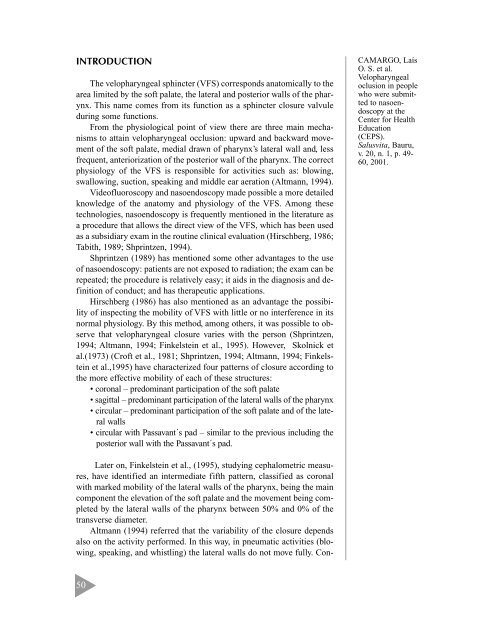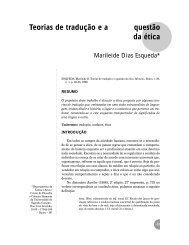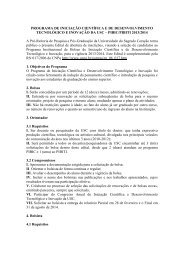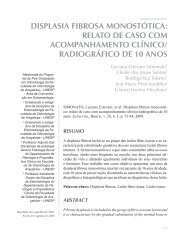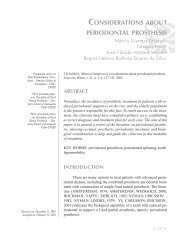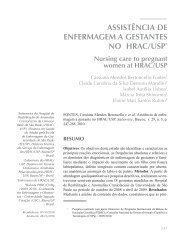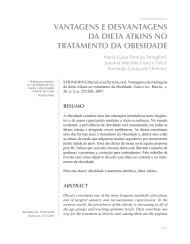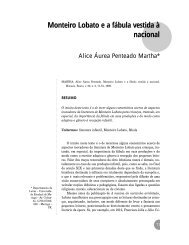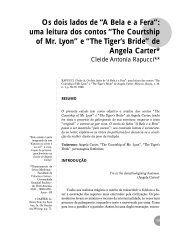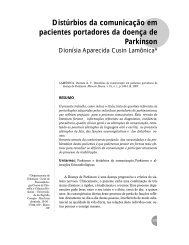INTRODUCTIONThe velopharyngeal sphincter (VFS) corresponds anatomically to thearea limited by the soft palate, the lateral and posterior walls of the pharynx.This name comes from its function as a sphincter closure valvuleduring some functions.From the physiological point of view there are three main mechanismsto attain velopharyngeal occlusion: upward and backward movementof the soft palate, medial drawn of pharynx’s lateral wall and, lessfrequent, anteriorization of the posterior wall of the pharynx. The correctphysiology of the VFS is responsible for activities such as: blowing,swallowing, suction, speaking and middle ear aeration (Altmann, 1994).Videofluoroscopy and nasoendoscopy made possible a more detailedknowledge of the anatomy and physiology of the VFS. Among thesetechnologies, nasoendoscopy is frequently mentioned in the literature asa procedure that allows the direct view of the VFS, which has been use<strong>da</strong>s a subsidiary exam in the routine clinical evaluation (Hirschberg, 1986;Tabith, 1989; Shprintzen, 1994).Shprintzen (1989) has mentioned some other advantages to the useof nasoendoscopy: patients are not exposed to radiation; the exam can berepeated; the procedure is relatively easy; it aids in the diagnosis and definitionof conduct; and has therapeutic applications.Hirschberg (1986) has also mentioned as an advantage the possibilityof inspecting the mobility of VFS with little or no interference in itsnormal physiology. By this method, among others, it was possible to observethat velopharyngeal closure varies with the person (Shprintzen,1994; Altmann, 1994; Finkelstein et al., 1995). However, Skolnick etal.(1973) (Croft et al., 1981; Shprintzen, 1994; Altmann, 1994; Finkelsteinet al.,1995) have characterized four patterns of closure according tothe more effective mobility of each of these structures:• coronal – predominant participation of the soft palate• sagittal – predominant participation of the lateral walls of the pharynx• circular – predominant participation of the soft palate and of the lateralwalls• circular with Passavant´s pad – similar to the previous including theposterior wall with the Passavant´s pad.CAMARGO, LaísO. S. et al.Velopharyngealoclusion in peoplewho were submittedto nasoendoscopyat theCenter for HealthEducation(CEPS).Salusvita, Bauru,v. 20, n. 1, p. 49-60, 2001.Later on, Finkelstein et al., (1995), studying cephalometric measures,have identified an intermediate fifth pattern, classified as coronalwith marked mobility of the lateral walls of the pharynx, being the maincomponent the elevation of the soft palate and the movement being completedby the lateral walls of the pharynx between 50% and 0% of thetransverse diameter.Altmann (1994) referred that the variability of the closure dependsalso on the activity performed. In this way, in pneumatic activities (blowing,speaking, and whistling) the lateral walls do not move fully. Con-50
CAMARGO, LaísO. S. et al.Velopharyngealoclusion in peoplewho were submittedto nasoendoscopyat theCenter for HealthEducation(CEPS).Salusvita, Bauru,v. 20, n. 1, p. 49-60, 2001.versely, in non-pneumatic activities (swallowing, suction and vomitingreflex) the movement of the wall is quite clear since it occurs in its allcourse. Kuehn & Moon (1998) also mentioned the difference among activitiesthat includes or not speech. They observed that maximum pointof strength in the velopharyngeal closure during swallowing tends to beinferior than during speech. This is most probably due to the action of theconstrictor muscles of swallowing.According to Altmann (1994), the velopharyngeal closure may alsovary quantitatively. It seems to follow some sort of hierarchy, being greaterin swallowing and decreasing along blowing, emission of consonantsand, finally, during emission of vowels.According to Shprintzen (1994), when the VFS structures are notproperly functioning there is a velopharyngeal insufficiency (VFI). As aconsequence, it is possible to observe a gap between such structures.Tabith (1989) states that VFI is, therefore, a communication betweenthe oropharyngeal and nasopharyngeal cavities resulting in differentsymptoms in speech, feeding and auditive function. As a consequencethere may appear hypernasality in the voice, compensatory articulatordisturbs, gagging, nasal reflux of food and repetitive otitis.Pinho & Joo (1995) reported respiratory and laryngeal compensationas result of alterations in the velopharyngeal closure. According to theseauthors, such compensations could be justified by the attempt of the individualof reducing the nasality by an extra effort of the vocal tract,which would be the main responsible for the voice disturbs.Hirschberg (1986) mentioned that the voice produced in a hyperfunctionalway could be considered as a compensatory mechanism leading todysphonia and even to the development of nodules in the vocal pads.This author reports 12% of such nodules in his sample.However, the velopharyngeal gap not always leads to the above-mentionedsymptom. Warren (1986) reported that no repercussion in the velopharyngealfunction in individuals with minimal velopharyngeal openingis also possible.Causes for VFI may be of organic and functional origin or a combinationof both. They could be acquired or congenital (Hirschberg, 1986).Among these, Shprintzen (1994) mentions the anomalies of the centraland peripheral nervous system, neuromuscular disturbs and difficultiesin the articulatory development. Cerebral palsy, craniofacial anomalies,surgeries in the adenoids and tonsils, their hypertrophy and trauma arealso reported as possible causes of VFI according to Shprintzen & Golding-Kushner(1989).Therefore, it is necessary a deeper knowledge of the VFS since insome pathological situations the first symptoms may appear in this region.Based in the literature and in the practice, it is possible to ascertainthat the velopharyngeal mechanism is complex and its physiological variability“seems to be the rule, not the exception” (Altmann, 1994). Researchersdo no exclude any of the different possibilities for the velo-51
- Page 1: ISSN 0101-9910r e v i s t aSALUSVIT
- Page 4 and 5: Olavo Speranza de Arruda - Depto. C
- Page 6 and 7: artigos, avaliados por especialista
- Page 8 and 9: Another relevant associated problem
- Page 10 and 11: 111123133147159167Eletromiografia d
- Page 12 and 13: utilização do Flutter ® VRP1 e d
- Page 14 and 15: Cada paciente compareceu ao Setor d
- Page 16 and 17: A quantidade média e total de secr
- Page 18 and 19: nobras convencionais (drenagem post
- Page 20 and 21: BARKER, A. F. ; BARDANA, E. J. Bron
- Page 23 and 24: A study of the conventional chestph
- Page 25 and 26: ANTUNES,Letícia C. de O. Aet al. s
- Page 27 and 28: ANTUNES,Letícia C. de O. Aet al. s
- Page 29 and 30: ANTUNES,Letícia C. de O. Aet al. s
- Page 31 and 32: ANTUNES,Letícia C. de O. Aet al. s
- Page 33: ANTUNES,Letícia C. de O. Aet al. s
- Page 36 and 37: INTRODUÇÃOO esfíncter velofarín
- Page 38 and 39: Faz-se necessário, portanto, um co
- Page 40 and 41: Croft et al. (1981) realizaram uma
- Page 42 and 43: a grande maioria (37 sujeitos), cor
- Page 44 and 45: divíduo, incluindo sua história p
- Page 46 and 47: Período: _________________________
- Page 49: Velopharyngeal oclusion in peoplewh
- Page 53 and 54: CAMARGO, LaísO. S. et al.Velophary
- Page 55 and 56: CAMARGO, LaísO. S. et al.Velophary
- Page 57 and 58: CAMARGO, LaísO. S. et al.Velophary
- Page 59 and 60: CAMARGO, LaísO. S. et al.Velophary
- Page 61 and 62: Avaliação da resistência aocisal
- Page 63 and 64: CARRARA,Carlos Eduardo etal. Avalia
- Page 65 and 66: CARRARA,Carlos Eduardo etal. Avalia
- Page 67 and 68: CARRARA,Carlos Eduardo etal. Avalia
- Page 69 and 70: CARRARA,Carlos Eduardo etal. Avalia
- Page 71 and 72: Shear bond strength of restorativem
- Page 73 and 74: CARRARA,Carlos Eduardo etal. Shear
- Page 75 and 76: CARRARA,Carlos Eduardo etal. Shear
- Page 77 and 78: CARRARA,Carlos Eduardo etal. Shear
- Page 79: CARRARA,Carlos Eduardo etal. Shear
- Page 82 and 83: INTRODUÇÃOA instrumentação, na
- Page 84 and 85: TABELA 1 - Média em mm e desvio-pa
- Page 86 and 87: Com relação à velocidade emprega
- Page 89 and 90: Evaluation of the level of safety o
- Page 91 and 92: DUARTE, MarcoA. H. et al. Evaluatio
- Page 93 and 94: DUARTE, MarcoA. H. et al. Evaluatio
- Page 95: DUARTE, MarcoA. H. et al. Evaluatio
- Page 98 and 99: A Organização Mundial da Saúde (
- Page 100 and 101:
TABELA 2- Distribuição dos pacien
- Page 102 and 103:
transtornos da via e do disco ópti
- Page 105 and 106:
Visual impairment as a cause ofreti
- Page 107 and 108:
HOYAMA, Erikaet al. Visualimpairmen
- Page 109 and 110:
HOYAMA, Erikaet al. Visualimpairmen
- Page 111 and 112:
Eletromiografia dos músculos reto
- Page 113 and 114:
PELEGRINOTTI,Idico Luiz et al.Eletr
- Page 115 and 116:
PELEGRINOTTI,Idico Luiz et al.Eletr
- Page 117 and 118:
PELEGRINOTTI,Idico Luiz et al.Eletr
- Page 119 and 120:
PELEGRINOTTI,Idico Luiz et al.Eletr
- Page 121:
PELEGRINOTTI,Idico Luiz et al.Eletr
- Page 124 and 125:
INTRODUCTIONA human being needs a m
- Page 126 and 127:
1. electromyographic activity of re
- Page 128 and 129:
percentage variation among the RC v
- Page 130 and 131:
such occurrence in due to the an in
- Page 132 and 133:
DELAGI, E. F.; PEROTTO, A.; IAZZETT
- Page 134 and 135:
INTRODUÇÃOOs materiais usados nas
- Page 136 and 137:
esterilização em autoclave. Essas
- Page 138 and 139:
TABELA 1 - Medidas descritivas da c
- Page 140 and 141:
TABELA 3 - Medidas descritivas da f
- Page 142 and 143:
Em relação à temperatura, este m
- Page 144 and 145:
COLAIZZI, F. A.; JAVID, N. S.; MICH
- Page 147 and 148:
Effect of autoclave sterilization u
- Page 149 and 150:
PEREIRAFILHO, ValfridoA. et al. Eff
- Page 151 and 152:
PEREIRAFILHO, ValfridoA. et al. Eff
- Page 153 and 154:
PEREIRAFILHO, ValfridoA. et al. Eff
- Page 155 and 156:
PEREIRAFILHO, ValfridoA. et al. Eff
- Page 157 and 158:
PEREIRAFILHO, ValfridoA. et al. Eff
- Page 159 and 160:
Avaliação bacteriológica do biof
- Page 161 and 162:
SANT’ANNA,Rute M. de F. etal. Ava
- Page 163 and 164:
SANT’ANNA,Rute M. de F. etal. Ava
- Page 165 and 166:
SANT’ANNA,Rute M. de F. etal. Ava
- Page 167 and 168:
Bacteriological evaluation of biofi
- Page 169 and 170:
SANT’ANNA,Rute M. de F. etal. Bac
- Page 171 and 172:
SANT’ANNA,Rute M. de F. etal. Bac
- Page 173 and 174:
SANT’ANNA,Rute M. de F. etal. Bac
- Page 175 and 176:
INSTRUÇÕES PARA OS AUTORES1 - Fin
- Page 177 and 178:
4- Norma para apresentação dos or
- Page 179 and 180:
INSTRUCTIONS TO CONTRIBUTORS1 - Sco
- Page 181 and 182:
4 - Presentation of originals4.1 -


